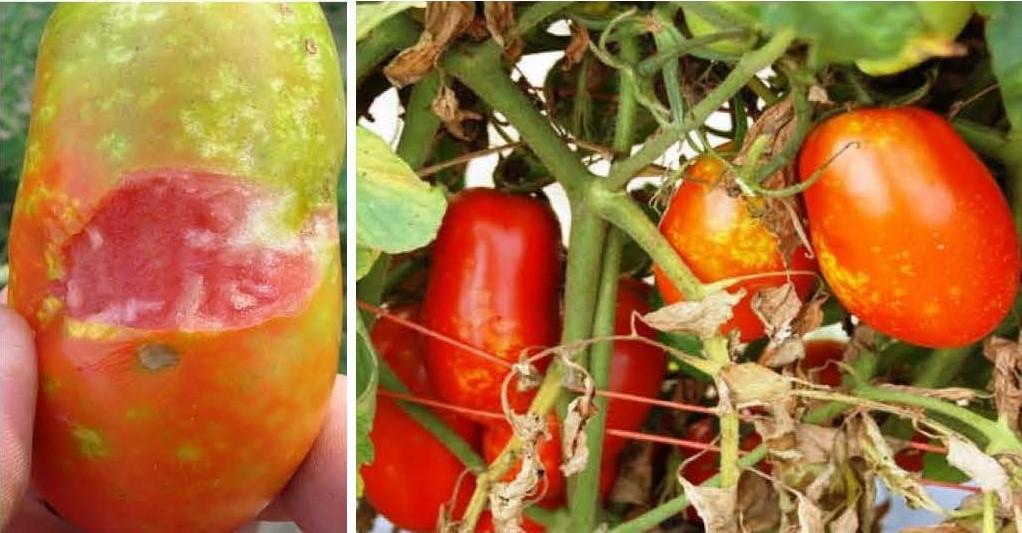On green fruit the damage appears as whitish areas with indistinct borders (Fig. 1). Individual spots may be 1/16 - 1⁄2 inch in diameter; or, the spots may merge and encompass a large area of the fruit surface. On ripe fruit the spots are golden yellow (Fig. 1). Peeling back the skin shows these areas as white shiny, spongy masses of tissue (Fig. 1). This damage is most common from late July or early August until the end of the season, concurring with the activity and feeding of stink bugs. SBs are often difficult to see and usually go unnoticed as they spend much of the day on the ground beneath tomato plants, which results in monitoring problems. Only a few are necessary to cause the appearance of cloudy spot on many tomato fruit. Brown and green stink bugs have been observed in larger than usual numbers in tomato fields. The brown marmorated stink bug does not appear to be causing much damage in vegetables so far this year compared with previous seasons. Feeding damage by the immatures of any of the stink bugs often appears as yellow “star-bursts” on red fruit (Fig. 2), which causes a very small shallow white spongy area under the star-burst (Fig. 3).
Stinkbugs are extremely difficult pests to monitor and control. There are no good methods for monitoring these pests. Traps do not work well, visually scouting for them has proven to be unreliable and too time consuming. Usually SB damage is only a nuisance, but this year it has resulted in moderate losses in some fields. Growers who have had damage before from stinkbugs may want to examine the edges of their fields carefully starting in mid-June for tomatoes with cloudy spot. There are some acceptable chemical choices for stink bug control. Pyrethroids (Warrior II, Hero EC, Tombstone and Mustang MAX), Venom or Scorpion can be used to reduce damage. It should be understood that none of the chemicals will give complete control, but will reduce damage compared with no chemical usage.
Print Article
Return to Vegetable Insect IPM
 English
English العربية
العربية Български
Български 简体中文
简体中文 繁體中文
繁體中文 Hrvatski
Hrvatski Čeština
Čeština Dansk
Dansk Nederlands
Nederlands Suomi
Suomi Français
Français Deutsch
Deutsch Ελληνικά
Ελληνικά हिन्दी
हिन्दी Italiano
Italiano 日本語
日本語 한국어
한국어 Norsk bokmål
Norsk bokmål Polski
Polski Português
Português Română
Română Русский
Русский Español
Español Svenska
Svenska Català
Català Filipino
Filipino עִבְרִית
עִבְרִית Bahasa Indonesia
Bahasa Indonesia Latviešu valoda
Latviešu valoda Lietuvių kalba
Lietuvių kalba Српски језик
Српски језик Slovenčina
Slovenčina Slovenščina
Slovenščina Українська
Українська Tiếng Việt
Tiếng Việt Shqip
Shqip Eesti
Eesti Galego
Galego Magyar
Magyar Maltese
Maltese ไทย
ไทย Türkçe
Türkçe فارسی
فارسی Afrikaans
Afrikaans Bahasa Melayu
Bahasa Melayu Kiswahili
Kiswahili Gaeilge
Gaeilge Cymraeg
Cymraeg Беларуская мова
Беларуская мова Íslenska
Íslenska Македонски јазик
Македонски јазик יידיש
יידיש Հայերեն
Հայերեն Azərbaycan dili
Azərbaycan dili Euskara
Euskara ქართული
ქართული Kreyol ayisyen
Kreyol ayisyen اردو
اردو বাংলা
বাংলা Bosanski
Bosanski Cebuano
Cebuano Esperanto
Esperanto ગુજરાતી
ગુજરાતી Harshen Hausa
Harshen Hausa Hmong
Hmong Igbo
Igbo Basa Jawa
Basa Jawa ಕನ್ನಡ
ಕನ್ನಡ ភាសាខ្មែរ
ភាសាខ្មែរ ພາສາລາວ
ພາສາລາວ Latin
Latin Te Reo Māori
Te Reo Māori मराठी
मराठी Монгол
Монгол नेपाली
नेपाली ਪੰਜਾਬੀ
ਪੰਜਾਬੀ Afsoomaali
Afsoomaali தமிழ்
தமிழ் తెలుగు
తెలుగు Yorùbá
Yorùbá Zulu
Zulu ဗမာစာ
ဗမာစာ Chichewa
Chichewa Қазақ тілі
Қазақ тілі Malagasy
Malagasy മലയാളം
മലയാളം සිංහල
සිංහල Sesotho
Sesotho Basa Sunda
Basa Sunda Тоҷикӣ
Тоҷикӣ O‘zbekcha
O‘zbekcha አማርኛ
አማርኛ Corsu
Corsu Ōlelo Hawaiʻi
Ōlelo Hawaiʻi كوردی
كوردی Кыргызча
Кыргызча Lëtzebuergesch
Lëtzebuergesch پښتو
پښتو Samoan
Samoan Gàidhlig
Gàidhlig Shona
Shona سنڌي
سنڌي Frysk
Frysk isiXhosa
isiXhosa

